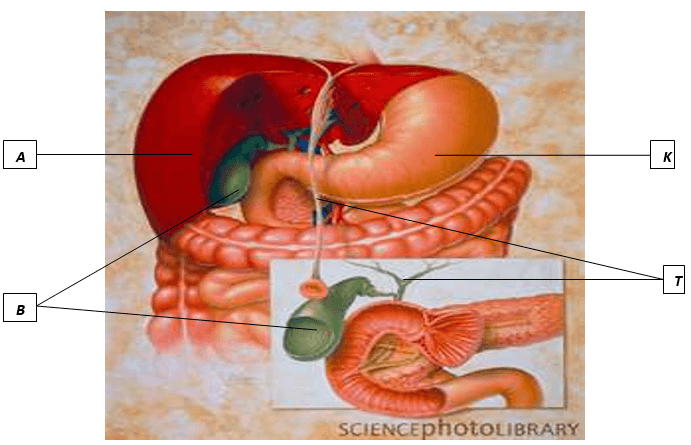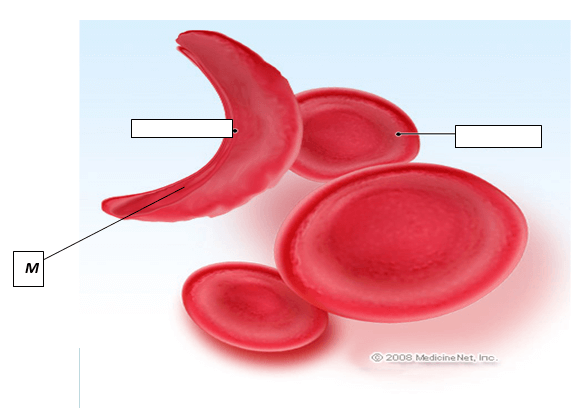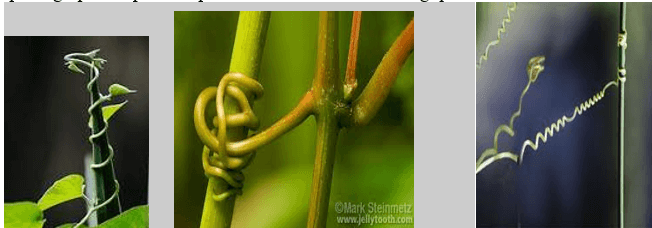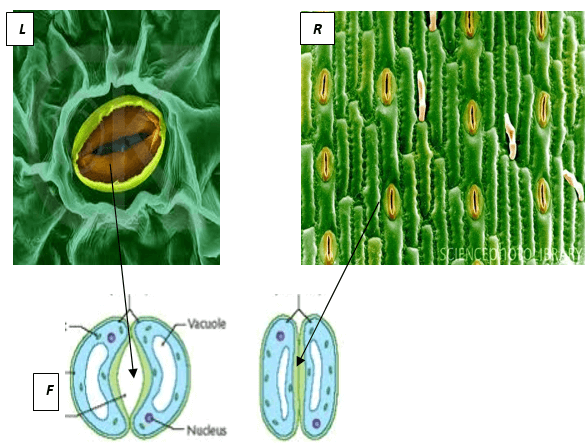INSTRUCTIONS TO CANDIDATE
- Answer all the questions
- You are required to spend the first 15 minutes of 13/4 hours allowed for this paper reading the whole paper carefully before commencing your work.
- Candidates may be penalized for recording irrelevant and incorrect spelling especially of technical terms.
FOR EXAMINERS USE ONLY.
|
QUESTIONS |
MAXIMUM SCORE |
CANDIDATE’S SCORE |
|
1 |
12 |
|
|
2 |
15 |
|
|
3 |
15 |
|
|
TOTAL |
40 |
|

QUESTIONS
- Use the photograph of mammalian digestive system and associated organs to answer the questions that follow.
-
- Name the structures named , (4mrks)

- Name an acid found in the structure labelled K. (1mrk)
- Name the juice stored in the structure labelled B and give its function. (2mrks)
Juice
Function. - In the photograph, identify with letter D where the function named in (iii) above takes place (1 mrk)
- Name the structures named , (4mrks)
- Use the the photograph of the mammalian blood component to answer the questions that follow.

- Identify the blood component. (1mrk)
- Name two structural adaptations of the blood component named in b (i) above to its function. (2mrks)
- Name a hereditary disease caused by the structure labeled M in the photograph. (1mrk)
- Explain what would happen to the blood components once they are placed in a concentrated salt solution. (2mrks)
-
- Use the photographs on plant response to answer the following questions.

- Name the type of response shown in the photographs. (1mrk)
- What is the survival value of the response shown? (1mrk)
- Explain how the response occurs. (3mrks)
- Use the photographs on plant structures to answer the following questions.

- Name the plant structure shown in the photographs. (1mrk)
- Name the part of the plant where the structure shown in the photos is found abundantly in terrestrial plants. (1mrk)
- Give the function of the structure named in 2(i) above. (1mrk)
- Observe photograph F carefully. Give three structural adaptations of the structure to its functions. (3mrks)
- Explain what would happen to the plant structures if they are placed in a hypotonic solution (3mrks)
-
- You are provided with solution Z . Divide it into three portions. Use one portion of Z, Benedict’s solution, iodine and a source of heat to carry out food tests.(8mrks)
Test
Procedure
Observations
Conclusion
- Measure one ml of DCPIP and put it in a test tube. To it add drops of the second portion of Z and record how many drops decolorizes DCPIP (1mrk)
- Boil the third portion of solution Z for two minutes. Repeat the procedure in (b) above and record the number of drops that decolorizes DCPIP (1mrk)
- Account for the difference in the number of drops used to decolorize DCPIP. (2mrks)
- You are provided with solution Z . Divide it into three portions. Use one portion of Z, Benedict’s solution, iodine and a source of heat to carry out food tests.(8mrks)

MARKING SCHEME
-
-
- A Liver
R Gall bladder
K Stomach
T Bile ducts - Hcl / Hydrochloric acid
- Bile
Emulsify fats to increase their surface area for digestion -

- A Liver
-
- Red blood cell
-
- biconcave disc shape to increase their surface area for oxygen transportation.
- Lack nucleus and other cell organelles to increase the surface area for packaging more oxygen.
- Has haemoglobin which has a high affinity for oxygen.
- Thin plasma membrane to reduce the distance through which gases diffuse.
- Sickle cell anemia
- The blood cell looses water through osmosis; shrink; and become crenated;
-
-
- Thigmotropism / haptotropism.
- Enable plants to climb to increase chances of obtaining sunlight for photosynthesis.
- Contact; influences migration; of auxins away from it; the side in contact with the plant has less auxins than the outer side; hence cell elongation is more than the side in contact; causing curving towards point of contact.; (6marks max 3 mrks).
-
- Guard cells
- Lower side of leaf
- Opening and closing of the stomata
-
- Thin elastic outer wall to enable the guard cell bulge out when turgid to open the stomata
- Crescent / bean shaped to create a pore at the centre ( stoma)
- Presence of chloroplasts to trap sunlight energy for photosynthesis max-3mrks
- Water gets into the plant cell through osmosis; swells; and becomes turgid
-
-
Rej. No change Starch absent;Test
Procedure
Observations
Conclusion
Reducing sugars;
To food/z add Benedict’s sln and heat;
No colour change;
Rej. No change
Reducing sugars absent;
Starch;
To food/ z add iodine;
No colour change;
Rej. No change
Starch absent;
- 3 Drops
- 8 drops
- High temperatures; destroy vitamins;
-
Download Biology Paper 3 Questions and Answers - Achievers Joint Mock Exams 2023.
Tap Here to Download for 50/-
Get on WhatsApp for 50/-
Why download?
- ✔ To read offline at any time.
- ✔ To Print at your convenience
- ✔ Share Easily with Friends / Students
